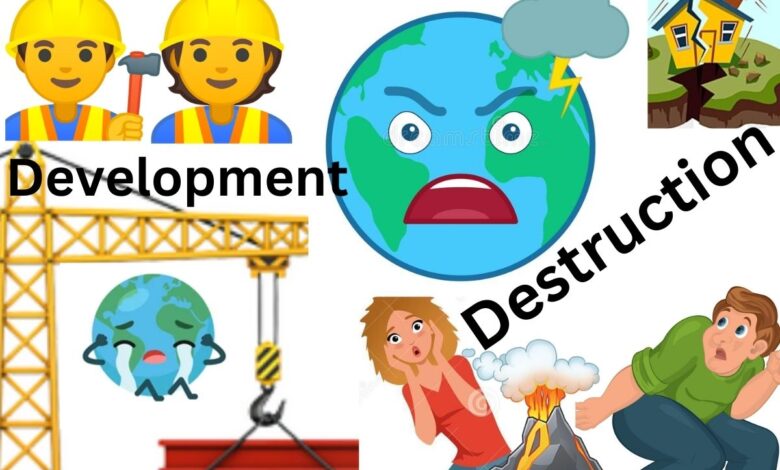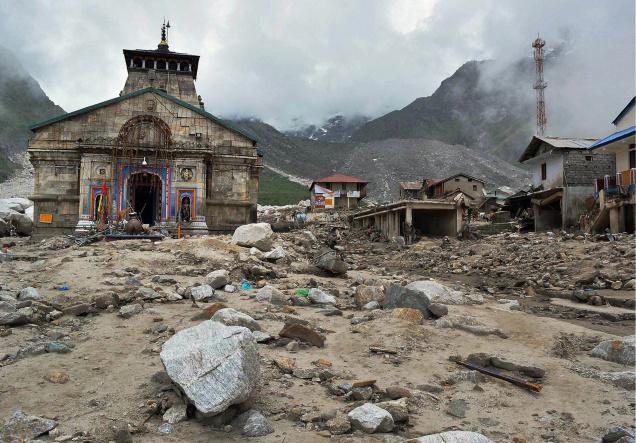Development at the cost of destruction – the joshimath saga.

In between the chaos going around the Joshimath situation, there is an old video going viral revolving around the speech of Late Union Minister Smt. Sushma Swaraj at Lok Sabha, after the deadly Kedarnath floods, took place in 2013.
The essence of the video is that the Late Minister is addressing the concern over the construction of bridges and tunnels in Uttarakhand, which may result in unfavorable conditions shortly. None of us could forget the situation that was created after the disaster of the Kedarnath floods; from the destruction of properties to lives to everything that came on its way.
The on-paper cause of the destruction was termed as the hefty amount of rainfall that the region experienced, which resulted in the melting of the Chorabari glacier and eventually the eruption of the Mandakini river. But is that this simple? Was it a negative natural call, or was it a product of unwanted human interference in nature?

Many environmentalists believed that the Kedarnath crisis was a man-made disaster. The following points were put forward to support their theory.
The area around Kedarnath was susceptible to natural disasters like earthquakes, landslides, and flash floods. Despite that, in the name of supporting tourism, approximately 25 million tourists visited the area in 2011. The state government, in favor of supporting and growing tourism in the region, allowed the building of an intricate network of roads, hotels, and lodges, that employed the use of heavy equipment in the disaster-prone region.
There is historical evidence from 1893, 1968, and 1970 that depicts that the region is already in the wake of disaster. Eventually, unplanned and careless construction and improper way of tourism management, all these already fragile ecosystems have increased even further in intensity to react badly to challenge nature.
Moreover, again, history repeats-the birth of the Joshimath crisis.
Cracks on the walls, fields, and drainage systems overflowing, muddy water flowing over the roads, and the deadliest of all, the terror of history being repeated….these are the scenes and feelings of Joshimath residents at this point. Yes, their town is sinking, and may vanish one day, resulting in one more deadly situation!
Moreover, the effect is not only present in Joshimath itself, but also the surrounding areas of Raini and Karnaprayag.

Experts from ancient times say that the heavy construction should have been stopped almost 4 decades ago! On contrary, the government has initiated a hydel ambitious project as a part of a controversial highway project in the region.
List of projects undertaken in the fragile ecosystem- despite historical warnings, like the deadly Kedarnath crisis.
- Tapovan Vishnugad Hydropower Project- constructed on the Dhauliganga River in the Chamoli district of Uttarakhand.
- Char Dham Project- the making of the National highway, which will connect the holy places of Uttarakhand.
Are these projects a ladder for development at the cost of humanity and nature!!!
The geographical importance of Joshimath.
The natural ground of Joshimath is situated 1800 meters above sea level in the northwestern district of Chamoli, in Uttarakhand. The geographical location of the town holds significance in many ways. The town has one major Indian army base and is one of the important routes aligning the strategic importance along the Indo-China border. Also, it is one of the circuits of Hindu pilgrimage sites that has a holy connection with the people, along with the gateway to many trekking sites.
The foundation of Joshimath.
Joshimath is a zone landslide prone. The town is situated on an ancient landslide, that has sand and stone as its base. This means there is no solid base for Joshimath. Therefore, when rains or snow rains hit the ground, the surface water penetrates them and loose soil destabilizes the land, resulting in the further occurrence of landslides.
Can a town sink?
The current situation of Joshimath can be termed as Land Subsidence. It is the phenomenon of the sinking of land, due to underground material movement. Since the town of Joshimath is established on sand and stone from historical landslides, it eventually washes away with the penetration of surface water in them, resulting in the breakdown of buildings and properties built over that land.

Apart from that, more than 90% of the city’s geography is not connected to any accurate and existing drainage systems. As a consequence of this, a major part of the population depends on soak pits, which eventually wash away with the soil sediments and contribute further to the occurrence of such land subsidence, aka land sink.
Heavy construction activities using giant equipment can further deteriorate the condition of the land. Not only landslides and floods, but the region is also prone to another terrific natural disaster, the earthquake.
The losses incurred by the society till now.
- Kedarnath floods(2013) – The deadliest act of nature made the loss of more than 5000 lives. The near loss of ruptured bridges and roads accounted for $285 million; the loss of dam projects was calculated for around $ 30 million, and monetary damage to state tourism was worth $195 million.
- Joshimath flash floods (2021) – In the chilly winters of February 2021, around 200 people lost their lives leaving their families devastated.
The present situation of Joshimath-not so sound.
The current situation in Joshimath is giving a warning sign as irreparable damage is being caused due to severe tunnel and hydro-power projects around Joshimath and other parts of the state. As the construction goes on, the voices of locals and environmentalists are being ignored, which can lead to another drastic calamity in near future.
As per the ISRO findings, using satellite images, it seems that the entire Joshimath may sink!! Also, the Narsimha temple and helipad of the Indian army are in sensitive zones.
If you think that the town will sink soon, just wake up. It already started sinking. The sinking started in April 2022, and till November same year, the town sank by 8.9 cm. This sinking process was a bit slow, but the rate spiked up in the last 2 months, and from December 27 last year to January 8 now, the land subsidence increased and the religious town of Joshimath sank by 5.4 cm, so much in just a dozen days.
The last call.
In the new year, when we all prayed for good fortune, the residents of Joshimath witnessed the unfortunate fate of their lands. Will all these developments help in building India or is it just a beginning of a trail of environmental violations, disasters, and deaths?
Edited by Prakriti Arora




